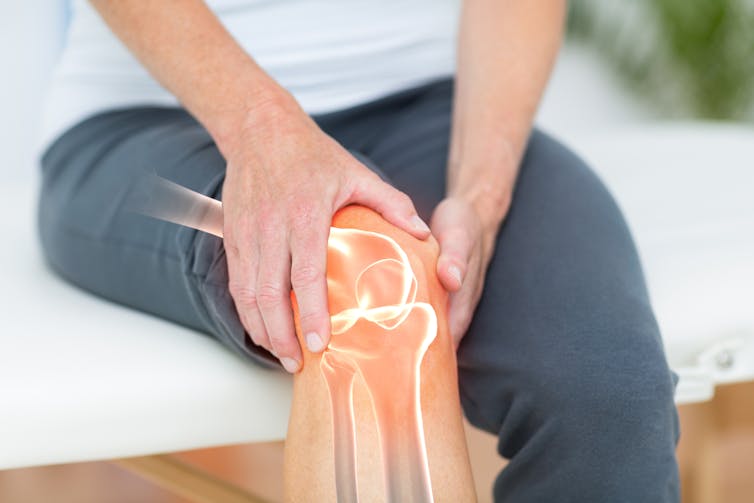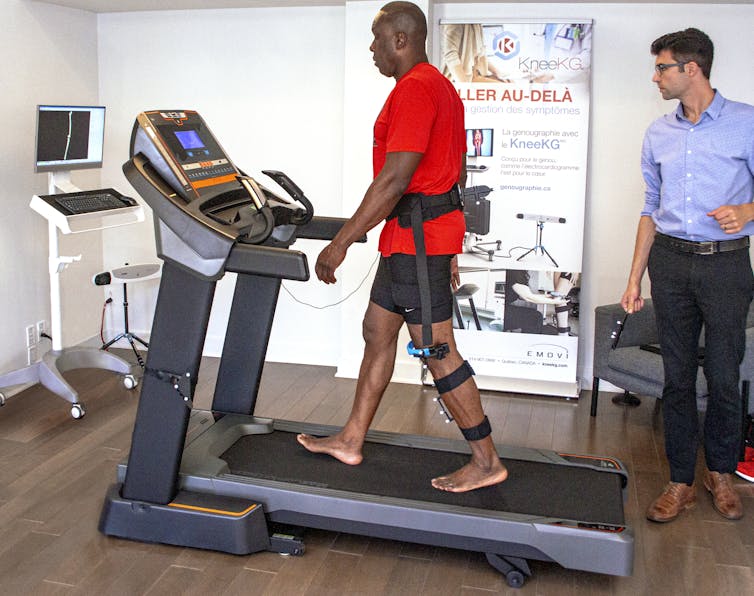The 3D technology that could revolutionize the treatment of osteoarthritis of the knee
 Osteoarthritis of the knee is not only associated with aging. It can also be caused by different stresses on the cartilage, such as a knee injury or a strenuous job.
(Shutterstock)
Nicola Hagemeister, École de technologie supérieure (ÉTS); Nathalie J Bureau, Université de Montréal, and Neila Mezghani, Université TÉLUQ
Osteoarthritis of the knee is not only associated with aging. It can also be caused by different stresses on the cartilage, such as a knee injury or a strenuous job.
(Shutterstock)
Nicola Hagemeister, École de technologie supérieure (ÉTS); Nathalie J Bureau, Université de Montréal, and Neila Mezghani, Université TÉLUQ
A new technology called knee kinesiography is changing the way doctors treat of osteoarthritis of the knee. This form of osteoarthritis affects nearly four million Canadians, or 13.6 per cent of the population, according to the Public Health Agency of Canada.
Osteoarthritis of the knee is most common in people over the age of 60, but it also affects a significant proportion of younger people, even those in their 40s. For reasons still unknown, women are more likely to develop osteoarthritis than men.
In osteoarthritis of the knee, the protective cartilage in the joint wears away over time, and can lead to bone rubbing on bone. The disease is associated with aging, but it can also be caused by injury or other forms of physical stress to the cartilage.
Anatomical abnormalities and other inherited factors can also lead to a mechanical dysfunction of the knee. This may result in a misaligned knee joint, increasing stress on the cartilage. It’s essential for clinicians to fully understand the dysfunction to correct it.
Our research in biomechanics, chronic pain, radiology, epidemiology, physiotherapy and data science led us to develop and evaluate the clinical utility of a new technology called knee kinesiography, used to treat patients with osteoarthritis in Québec.
 Knee kinesiography is performed using a harness attached to certain strategic areas of the leg. In the photo, athlete Bruny Surin is being evaluated using this technology.
(Author provided)
Knee kinesiography is performed using a harness attached to certain strategic areas of the leg. In the photo, athlete Bruny Surin is being evaluated using this technology.
(Author provided)
Clinicians currently diagnose knee osteoarthritis through examination and X-rays, and assess mechanical dysfunction using a questionnaire and clinical observation of the knee.
But questionnaires are subjective and observations aren’t quantified. The clinician observes the leg with the naked eye, but does not take measurements. This makes it difficult for the physician to assess exactly what’s wrong, to determine when the problems began and to identify what’s causing stress to the joint and its deterioration.
Knee movements in 3D
Health-care professionals can offer patients treatment to relieve pain, as well as physiotherapy exercises. But to correct knee dysfunctions, they must be able to target dysfunctions that are not visible to the naked eye.
Knee kinesiography, which was commercialized in 2011 after 15 years of research, could be a game changer. It is to the knee what the electrocardiogram is to the heart. It is performed using a harness attached to specific areas of the leg to analyze the knee while it is in motion.
This technology was developed by researchers from the École de technologie supérieure, the Centre de recherche du Centre hospitalier de l'Université de Montréal (CHUM) and Université TÉLUQ.
Bruny Surin talks about his experience using knee kinesiography to treat osteoarthritis.
Because this technology measures three-dimensional movement of the knee in real time, as well as rotations that are not visible to the naked eye, it enables health professionals to assess the joint with precision and accuracy. By providing motion analysis that detects deviations from what is considered normal movement, the technology allows health professionals to understand the source of the stresses on the cartilage.
Personalized care
Using this technology, professionals can offer personalized treatment for the source of the problem, such as neuromuscular exercises that can be done at home or under the supervision of a physiotherapist or kinesiologist.
Laurent Duvernay-Tardif, a physician and athlete, explains how knee kinesiography can help heal and prevent knee injuries.
According to results of our clinical study, conducted on 515 patients, this technology shows great promise. Patients who received knee kinesiography and an individualized care plan were able to correct several measured biomechanical dysfunctions. Nearly nine out of 10 (88 per cent) of those who participated in the clinical study reported doing their exercises for at least three months, which demonstrated that they were committed to their treatment. Exercise adherence is a major issue in studies that analyze the effect of an exercise program.
In addition, the researchers observed more improvement in the functional status of the knee for these patients, compared to the control group. These patients reported less pain and symptoms, and felt better able to perform their daily activities. In addition, they reported greater satisfaction with their care and better results on functional tests.
Knee kinesiography is now offered in more than 100 clinics and hospitals in eight countries and is available in private clinics in Québec. Studies are underway to evaluate the impact of this tool on private costs and public health services, with a view to offering it in the public system (hospitals and clinics).
In addition to offering hope to thousands of patients who suffer from osteoarthritis of the knee, this innovation demonstrates, once again, that Québec engineering fully deserves the praise it has earned.
Nicola Hagemeister, Professeure en biomécanique, École de technologie supérieure (ÉTS); Nathalie J Bureau, Professeur titulaire Faculté de médecine - Département de radiologie, radio-oncologie et médecine nucléaire, Université de Montréal, and Neila Mezghani, Professeure, Département Science et Technologie, Université TÉLUQ
This article is republished from The Conversation under a Creative Commons license. Read the original article.